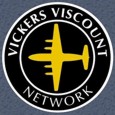
May 1957 to July 1973
British European Airways Corporation (BEA)
G-AOHO - c/n 164 - a V.802 series Viscount
United Kingdom registered
February 1953
An order was placed for the first 800 series Viscount which was specifically designed for British European Airways Corporation (BEA).
This was the 15th Type 802 ordered by British European Airways Corporation (BEA).
Production Aircraft No. 15 - the 15th production 800 series Viscount built,
was the 15th 800 series Viscount fuselage assembled at Hurn, Bournemouth, Hampshire, England,
and the 15th 800 series Viscount assembled at Weybridge, Surrey, England.
Production Order No. F15/802. Sales Order No. F15/63B. Stock Order No. F15/26B.
22 October 1956
Fuselage assembly commenced at Hurn Airport, Bournemouth, England.
December 1956
Fuselage transported by road from Hurn Airport, Bournemouth, Hampshire, England to Weybridge, Surrey, England.
29 December 1956
Fuselage to Erecting Shop 'E' at Weybridge, Surrey, England.
26 April 1957
First flight from Brooklands Airfield, Weybridge, Surrey, England.
It landed at Wisley Airfield, Surrey, England for fitting out and test flying.
2 May 1957
Noted at Blackbushe Airport, Hampshire, England.
4 May 1957
Delivered to British European Airways (BEA) named as 'R M A Samuel Wallis'.
February 1958
Carried an 18 man British team to Moscow to discuss the technical aspects of a proposed direct London, England to Moscow, USSR air service. The principal items on the agenda related to engineering arrangements, traffic control and navigational aids available on the sector between Copenhagen and Moscow. Carried in its hold was a specially made Dagenite battery starting unit, taken to avoid possible embarrassment arising from the severe weather conditions expected in Moscow. This service did not start until 14 May 1959.
 Viscount illustrations by David Carter Viscount illustrations by David Carter
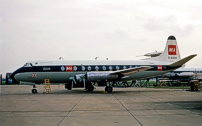
BEA
‘Red Square‘ livery
March 1959
A new BEA 'Red Square' livery was adopted and aircraft were repainted during the early 1960s when they next went in for overhaul.
Sadly, after repainting, the aircraft no longer carried a name including the nameplate on the forward cabin bulkhead.
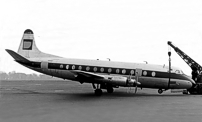
Suffered an accident at
Tegel, Berlin, West Germany
7 November 1959
Noted at Gatwick Airport, Surrey, England due to a London Airport (Heathrow) weather diversion.
15 December 1959
Noted at Blackbushe Airport, Hampshire, England due to a London Airport (Heathrow) weather diversion.
17 March 1963
Nose undercarriage leg collapsed after landing short at Tegel Airfield, Berlin, West Germany.
The flight had originated from Langenhagen Airport, Hannover, West Germany and was scheduled to land at Templehof Airport, Berlin, West Germany but after two aborted landings due to poor visibility the captain elected to divert to the military airfield at Tegel.
At the time of the accident the runway approach lighting was being modified which involved displacing the runway 26L threshold by some 900 feet. This meant that the first section of the runway was marked with different lights.
The Captain had not been advised of these changes and touched down 200 feet short of the actual useable runway resulting in the collapse of the nose undercarriage leg, curled propellers and shockloaded Rolls-Royce Dart engines.
There were no reported injuries to the 33 passengers and 4 crew on board.
Repaired locally and returned to service.
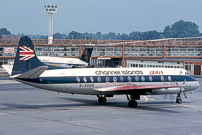
BEA
‘Flying Union Jack‘ livery
circa 1968
A new BEA ‘Flying Union Jack‘ livery was adopted and most aircraft were repainted when they went in for major overhaul, which took some of them into the early 70s before this was accomplished.
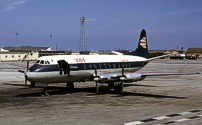
BEA
‘Gibair‘ livery
Summer 1973
Noted operating BEA services with small Gibair titles and logo on the rear fuselage on the London to Gibraltar route which was an early form of code sharing.
31 July 1973
Transferred to British Airways (BA) due to a corporate merger.
 FURTHER READING: Books about BEA - British European Airways FURTHER READING: Books about BEA - British European Airways
|

